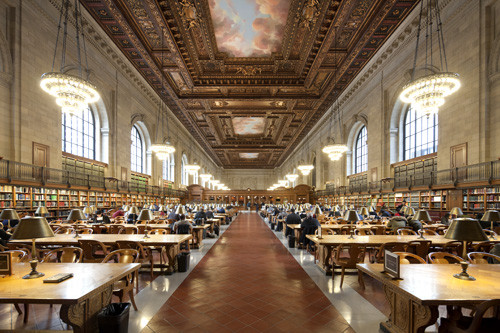
PREV ARTICLE
NEXT ARTICLE
FULL ISSUE
PREV FULL ISSUE
ARTICLE: THE PUBLIC LIBRARY IS STILL HERE
The article from Metropolis magazine discusses the transformation of the public library in the digital age: "A funny thing happened on the way to its predicted obsolescence.
The library became more popular than ever." Here's an excerpt. -Editor

Sometime last year, the New York Public Library (NYPL) retired its pneumatic-tube system, which had been used to request books for more than a century. This change was made without ceremony or fanfare; I learned of it unexpectedly, when I walked into the catalog room prepared to deliver a call slip to a clerk behind a large wooden desk, only to find a notice directing me elsewhere. For a few moments, I stood there, unmoored, before moving along as instructed. That pneumatic call system had changed little since the library’s opening in 1911. You still filled out a slip, and you still turned that slip over to a clerk, who would load it into a metal cartridge. With a slurpy shoomp, the cartridge would be driven by air pressure to a station down in the stacks, where another clerk would retrieve your book, which was then sent back up to the call desk by a dumbwaiter. In recent years, this procedure would take about 20 minutes. In decades past, I’m told, it was closer to five. One could hardly contrive a more blatant metaphor for the uneasy shift, in the world of letters, from the physical to the digital. The very future of the book, and the printed word in general, is uncertain. We’re at a moment of profound change in the way we consume information, and that change is shaping the kinds of information we value. It is also shaping the spaces in which we consume information. How does one even begin to think about designing libraries in a time of rapidly developing technologies and shifting programs? “A lot of basic assumptions about what a library is and should be are on the table in a way that they haven’t been since the industrialization of printing,” says Jeffrey T. Schnapp, faculty director of metaLAB at Harvard and a professor of romance languages at the university’s Graduate School of Design. “There’s a shift of their core identity, away from places where documents are housed, to physical structures that can serve as nodes that add value to the act of consultation.” To put things a bit more simply, the book—the object that, for so long, defined the library—is no longer its primary focus. Indeed, as content is increasingly digitized, one might ask whether the library is even a viable building type for the future. “My guess is that most libraries will cease to exist,” says David Bell, a professor at Princeton’s Department of History who writes on the subject. “People who love the physical book will see this as one of the great moments of barbarism in history.” Most susceptible are smaller libraries—in high schools, for example—that might easily be replaced by electronic workstations. Library space may be hard to justify when the content of a quarter of a million books fits onto a chip that you can slip into your pocket. But for all their supposed obsolescence, libraries remain vital places, and many of them are more crowded than ever. Printed material, however, is not always the primary draw. “Increasingly, people can use that material anywhere that they want to, which means they come to the library for other needs,” says Jim Neal, the vice president for information services and university librarian at Columbia University. “They come to study. They come to work together. They come to use technology they can’t carry around. They come here to consult with experts, with librarians.” The pressure to accommodate “other needs” is especially strong at public libraries, which are increasingly taking on civic functions that far exceed the historical mission of serving books to readers. “Libraries are the new cathedrals of our society. They’re very important sanctuaries,” says the architect Bing Thom, whose new public library in Surrey, British Columbia, a suburb of Vancouver, was designed as a space of communal engagement. “People are living in smaller and smaller spaces, so the library becomes the place you escape to for socialization, for solitude, to take a breath. It’s the last space in society that’s free. Even for the homeless. There is a sense of democracy; it is a common space we all share.”
Be sure to read the whole article online - it also discusses the controversial plans to revamp the New York Public Library, sending millions of books to offsite storage.
-Editor
For writers and scholars, the idea of a library without books, however inevitable it may appear, is something more than an inconvenience. “It’s a disaster for research,” according to Andrew Abbott, a sociologist at the University of Chicago who has studied library use. “You can’t do really cutting-edge research when, a dozen times a day, you’re going to have to wait until tomorrow to get something. It’s like apes swinging through trees. When you’re swinging from vine to vine, and you reach out for the next branch and there’s no vine there, you just fall. That’s what off-site storage is like. You can’t do research that way.” The NYPL’s pneumatic-tube system may have been well past the age of retirement when it was finally put to rest last year, but it’s worth keeping in mind that, even on its last day, after a hundred years of service, it still got you the book you called in 20 minutes. If administrators have their way, the library’s new, high-tech delivery system will accomplish that same task, and do so without the need for old-fashioned call slips or antiquated metal tubing. It just might take 20 hours. To read the complete article, see: Still Here (www.metropolismag.com/story/20120720/still-here)

Wayne Homren, Editor The Numismatic Bibliomania Society is a non-profit organization promoting numismatic literature. See our web site at coinbooks.org. To submit items for publication in The E-Sylum, write to the Editor at this address: whomren@gmail.com To subscribe go to: https://my.binhost.com/lists/listinfo/esylum All Rights Reserved. NBS Home Page Contact the NBS webmaster 
|